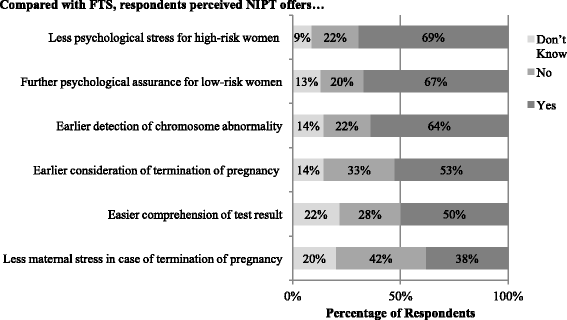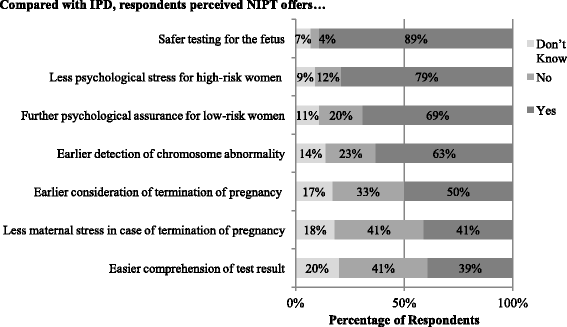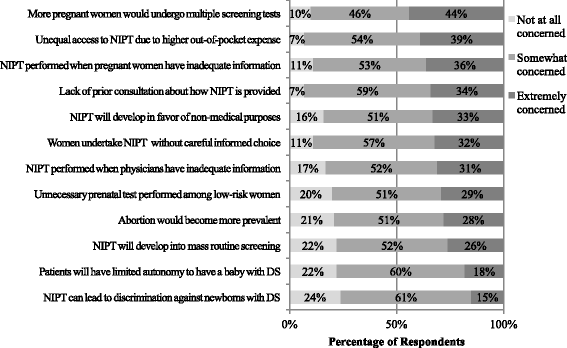Obstetric professionals' perceptions of non-invasive prenatal testing for Down syndrome: clinical usefulness compared with existing tests and ethical implications
- PMID: 28870159
- PMCID: PMC5583989
- DOI: 10.1186/s12884-017-1474-6
Obstetric professionals' perceptions of non-invasive prenatal testing for Down syndrome: clinical usefulness compared with existing tests and ethical implications
Abstract
Background: While non-invasive prenatal testing (NIPT) for fetal aneuploidy is commercially available in many countries, little is known about how obstetric professionals in non-Western populations perceive the clinical usefulness of NIPT in comparison with existing first-trimester combined screening (FTS) for Down syndrome (DS) or invasive prenatal diagnosis (IPD), or perceptions of their ethical concerns arising from the use of NIPT.
Methods: A cross-sectional survey among 327 obstetric professionals (237 midwives, 90 obstetricians) in Hong Kong.
Results: Compared to FTS, NIPT was believed to: provide more psychological benefits and enable earlier consideration of termination of pregnancy. Compared to IPD, NIPT was believed to: provide less psychological stress for high-risk women and more psychological assurance for low-risk women, and offer an advantage to detect chromosomal abnormalities earlier. Significant differences in perceived clinical usefulness were found by profession and healthcare sector: (1) obstetricians reported more certain views towards the usefulness of NIPT than midwives and (2) professionals in the public sector perceived less usefulness of NIPT than the private sector. Beliefs about earlier detection of DS using NIPT were associated with ethical concerns about increasing abortion. Participants believing that NIPT provided psychological assurance among low-risk women were less likely to be concerned about ethical issues relating to informed decision-making and pre-test consultation for NIPT.
Conclusions: Our findings suggest the need for political debate initially on how to ensure pregnant women accessing public services are informed about commercially available more advanced technology, but also on the potential implementation of NIPT within public services to improve access and equity to DS screening services.
Keywords: Attitude; Cell-free fetal DNA; Clinical decision-making; Down syndrome; Ethical concern; Hong Kong; Informed consent; Non-invasive prenatal test.
Conflict of interest statement
Ethics approval and consent to participate
The Joint Chinese University of Hong Kong – New Territories East Cluster Clinical Research Ethics Committee approved this study. A written informed consent was obtained from all survey respondents to participate in the study.
Consent for publication
Not applicable.
Competing interests
The authors declare that they have no competing interests.
Publisher’s Note
Springer Nature remains neutral with regard to jurisdictional claims in published maps and institutional affiliations.
Figures



Similar articles
-
Service provision of non-invasive prenatal testing for Down syndrome in public and private healthcare sectors: a qualitative study with obstetric providers.BMC Health Serv Res. 2018 Sep 21;18(1):731. doi: 10.1186/s12913-018-3540-9. BMC Health Serv Res. 2018. PMID: 30241520 Free PMC article.
-
Limits to the scope of non-invasive prenatal testing (NIPT): an analysis of the international ethical framework for prenatal screening and an interview study with Dutch professionals.BMC Pregnancy Childbirth. 2018 Oct 19;18(1):409. doi: 10.1186/s12884-018-2050-4. BMC Pregnancy Childbirth. 2018. PMID: 30340550 Free PMC article.
-
Motivations for undertaking DNA sequencing-based non-invasive prenatal testing for fetal aneuploidy: a qualitative study with early adopter patients in Hong Kong.PLoS One. 2013 Nov 27;8(11):e81794. doi: 10.1371/journal.pone.0081794. eCollection 2013. PLoS One. 2013. PMID: 24312358 Free PMC article.
-
Facilitating informed choice about non-invasive prenatal testing (NIPT): a systematic review and qualitative meta-synthesis of women's experiences.BMC Pregnancy Childbirth. 2019 Jan 14;19(1):27. doi: 10.1186/s12884-018-2168-4. BMC Pregnancy Childbirth. 2019. PMID: 30642270 Free PMC article.
-
Noninvasive Prenatal Genetic Testing: Current and Emerging Ethical, Legal, and Social Issues.Annu Rev Genomics Hum Genet. 2015;16:369-98. doi: 10.1146/annurev-genom-090314-050000. Annu Rev Genomics Hum Genet. 2015. PMID: 26322648 Review.
Cited by
-
Audit of the first > 7500 noninvasive prenatal aneuploidy tests in a Swiss genetics center.Arch Gynecol Obstet. 2022 May;305(5):1185-1192. doi: 10.1007/s00404-021-06203-7. Epub 2021 Sep 17. Arch Gynecol Obstet. 2022. PMID: 34533609 Free PMC article.
-
Prenatal screening in the era of non-invasive prenatal testing: a Nationwide cross-sectional survey of obstetrician knowledge, attitudes and clinical practice.BMC Pregnancy Childbirth. 2020 Oct 1;20(1):579. doi: 10.1186/s12884-020-03279-y. BMC Pregnancy Childbirth. 2020. PMID: 33004009 Free PMC article.
-
Service provision of non-invasive prenatal testing for Down syndrome in public and private healthcare sectors: a qualitative study with obstetric providers.BMC Health Serv Res. 2018 Sep 21;18(1):731. doi: 10.1186/s12913-018-3540-9. BMC Health Serv Res. 2018. PMID: 30241520 Free PMC article.
-
Obstetrical provider knowledge and attitudes towards cell-free DNA screening: results of a cross-sectional national survey.BMC Pregnancy Childbirth. 2018 Jan 23;18(1):40. doi: 10.1186/s12884-018-1662-z. BMC Pregnancy Childbirth. 2018. PMID: 29361931 Free PMC article.
-
Healthcare professionals' perspectives on and experiences with non-invasive prenatal testing: a systematic review.Hum Genet. 2025 Apr;144(4):343-374. doi: 10.1007/s00439-025-02736-y. Epub 2025 Apr 9. Hum Genet. 2025. PMID: 40205233 Free PMC article.
References
MeSH terms
LinkOut - more resources
Full Text Sources
Other Literature Sources
Medical

